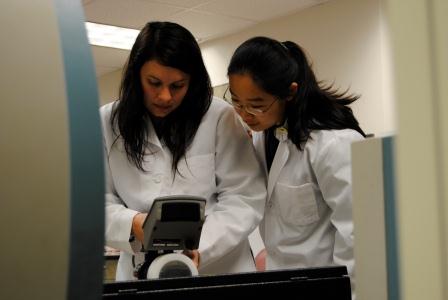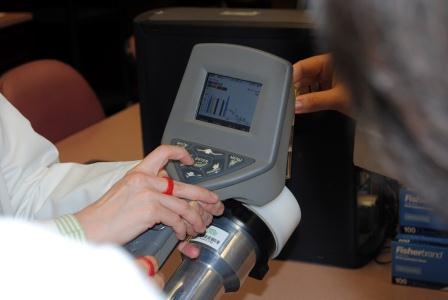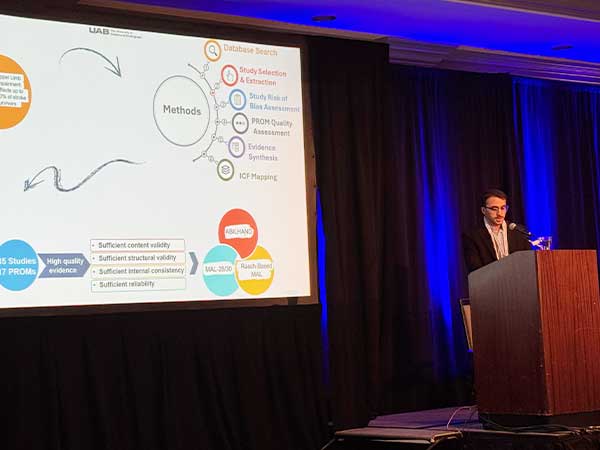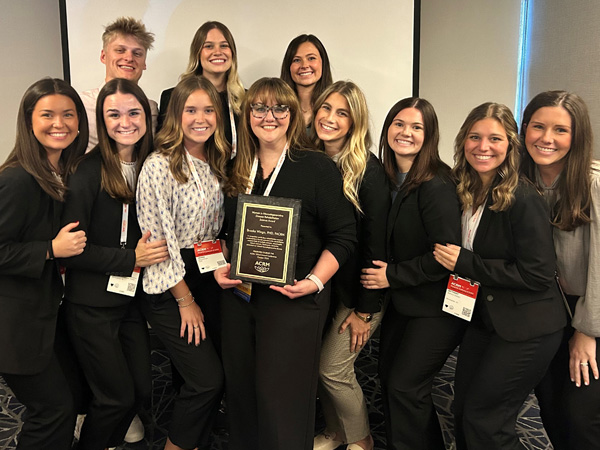 Norman E. Bolus, MPH, CNMT, Halie Stephenson, Shannon PettwayThe University of Alabama at Birmingham offers a class where students play hide and seek.
Norman E. Bolus, MPH, CNMT, Halie Stephenson, Shannon PettwayThe University of Alabama at Birmingham offers a class where students play hide and seek.However, they are not looking for each other and they cannot see what they are looking for.
The ‘hider’ is a radioactive isotope, which you will remember as a radioisotope from your days in high school Chemistry.
The UAB class, offered by the Nuclear Medicine Technology program, is NMT 421L. And it provides students with a rare, hands-on opportunity to personally use a SAM 940.
“It was very intense using a SAM 940!” said Halie Stephenson, a senior in the NMT program.
The SAM 940, known in the radiation field as the “Defender and Revealer,” is a groundbreaking Radiation Isotope Identifier. It is used by the U.S. Department of Homeland Security, food and drug inspectors and HAZMAT first responders. It is now a state-of-the-art learning device for students in the UAB NMT program.
“While most portable survey meters will only tell you if there is radiation present, the SAM 940 spectrometer will tell you the type of radiation, the amount of radiation and whether or not the area is safe,” says Norman E. Bolus, NMT program director, assistant professor, Department of Clinical and Diagnostic Sciences.
 Alisha Lawton and Tianyi Yu use the SAM 940“I was impressed that the screen was very detailed yet easy to read,” said senior NMT student Alisha Lawton. “The SAM 940 was easy to operate too. I did not have any prior training before using it for the first time and I was able to quickly and accurately identify the isotope.”
Alisha Lawton and Tianyi Yu use the SAM 940“I was impressed that the screen was very detailed yet easy to read,” said senior NMT student Alisha Lawton. “The SAM 940 was easy to operate too. I did not have any prior training before using it for the first time and I was able to quickly and accurately identify the isotope.”The SAM 940 uses a patented algorithm called Quadratic Compression Conversion. This allows real-time analysis which enhances the ability to locate and identify radioactive sources.
Bolus says the machine was specifically designed to be lightweight and easy to operate for use in the field.
“This state-of-the-art tool is a great acquisition for our students to learn the latest technology in their field and it is available for the UAB and Birmingham communities in case there is ever a radiation emergency,” said Bolus.
The NMT faculty and students also regularly work with the UAB Center for Patient Safety and Advanced Medical Simulation. They work through scenarios where a SAM 940 can be used in scenarios such as dirty bomb explosions or nuclear spills.
 The SAM 940 costs between $10,000 - $15,000“It is a blessing to have such a good program and instructors who care enough to continually make the program better by getting new equipment and creating new avenues for the students to experience first-hand, rather than just learning about this in a lecture or from a book,” said Stephenson.
The SAM 940 costs between $10,000 - $15,000“It is a blessing to have such a good program and instructors who care enough to continually make the program better by getting new equipment and creating new avenues for the students to experience first-hand, rather than just learning about this in a lecture or from a book,” said Stephenson.“A typical SAM 940 is very expensive, typically costing in the range of $10,000 to $15,000. For a true learning experience you only want one student operating the machine at a time,” said Bolus. “We average 18 students per year and it would be great to increase our instrumentation in the lab to enhance the student experience. A large portion of this acquisition was made available by using the NMT program gift account. By contributing to this account, the UAB NMT program can continue to offer the newest instrumentation, phantoms and other equipment for our students.”
UAB is known for producing graduates that are prepared to respond to emergencies and skilled at the newest technologies. And even though funding for some academic programs decreases the threat of terrorist attacks and natural disasters remains constant. If you would like to support the NMT program or other School of Health Professions program gift accounts please contact Senior Development Director Katie Adams at 205-996-5469 or katiedav@uab.edu.

